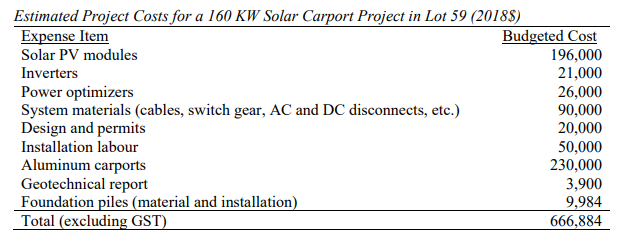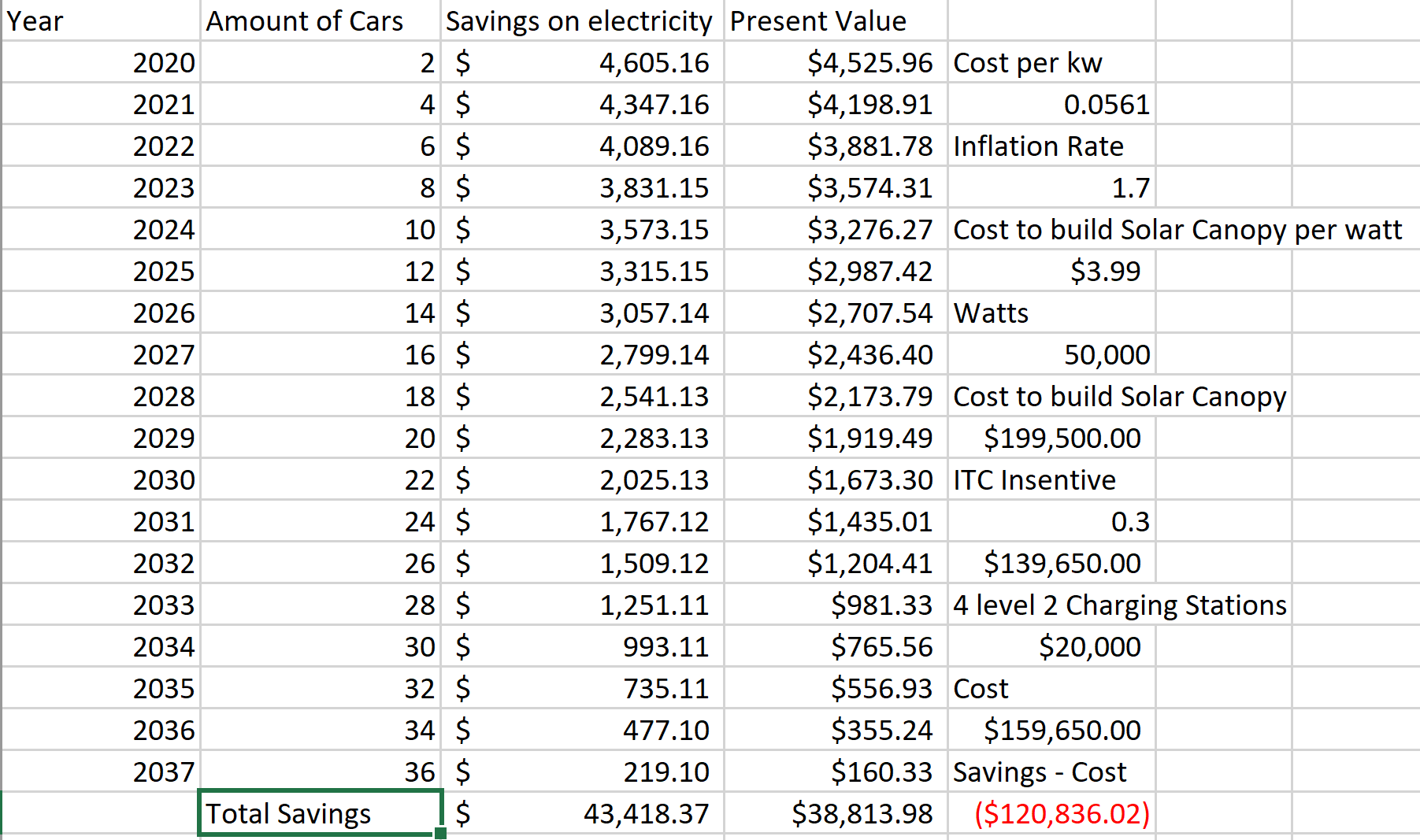The economic analysis for this project needs to be heavily considered if Lafayette were to actually implement this project. The main focus of this economic analysis is going to be the solar carport. As talked about in prior sections, while electric vehicles do reduce emissions, they mainly just shift the emissions from the car itself to the grid that produces the electricity. This is why we find it necessary to consider the cost of the solar canopy first before considering vehicle cost. In this section, we will cover both financial and non financial benefits to the solar carport as well as the total cost of the solar carport.
To start, as stated in the social contexts, a solar carport would align directly with Lafayette’s plan to be net zero by 2035. The solar carport would be a way to show the Lafayette community that the administration is dedicated to achieving these goals. While Lafayette has done a lot to move towards carbon neutrality, many of the steps the school has taken are not incredibly obvious. The solar carport is something that screams sustainability and would be a beacon to the school to showcase Lafayette’s commitment to the Climate Action Plan 2.0. The Environmental Protection Agency has a presentation called Solar Carports: Turning University Parking Facilities into Renewable Electricity Plants, in which multiple benefits to building a solar carport are presented . These benefits include:
- Reduce the college’s carbon footprint
- Aligns directly with the schools goals
- Reduce electricity expenditures and hedge against future cost increases
- We would be spending less on electricity which helps reduce the risk of the increase in the cost of electricity
- Increase efficiency of under-utilized space
- Bushkill parking lot has the potential to be much more than just a parking lot
- Improve parking experience for students, staff, and visitors
- Protects those in the parking lot from snow, rain, and harsh sunlight
- Encourage environmentally-friendly forms of transportation
- More people willing to bring their electric vehicles to school if they know charging is available
While the project itself will cost money, it will also generate revenue by lowering electricity cost. On top of this there are multiple intrinsic values that are important for both the reputation of Lafayette as a member of the American College and University Presidents’ Climate Commitment (ACUPCC). There are also benefits that the solar carport has for those using the parking facilities. The solar carport provides protection from the elements from the sun, rain, and snow for both the car and it’s owner (EPA). In the summer months, the shade will help with the fuel economy of any vehicle in the parking lot as “AC use can reduce a conventional vehicle’s fuel economy by more than 25% particularly on short trips” (Fuel Economy in Hot Weather). All of these benefits are the reason that the school would accept the loss of money to conduct the solar carport project.
In order to get a better perspective of the cost of this project, it is important to look for similar projects to find out how they were priced. Jessica Polivchuk wrote an academic document called Exploring the Feasibility and Costs and Benefits of Solar Carports for the Calgary Parking Authority in which Polivchuk does extensive research on the cost and benefits of a solar carport project for the Calgary Parking Authority in Canada. Polivchuk lays out the projected costs for a 160KW Solar Carport in this table below.

Figure 12. Estimated Project Costs for a 160 KW Solar Carport (Polivchuk 25)
As we can see from this table, there are many costs that go into a solar carport projects. The main ones are the Solar PV modules and the physical carport bodies. Energysage Solar Marketplace has reported that it cost approximately $3.99 to build a solar carport. Since we do not have the time in this project to conduct an entirely accurate estimate, we can check to see if this number is accurate enough for us to use. If we use the Energysage estimate, we find that Polivchuk’s project would have costed 160,000*3.99= $638,400 which is not far off from the $666,884 that the project cost. The Energysage estimate is slightly below the actual cost of Polivchuk’s projections, however the cost will certainly vary based on a multitude of factors. This does show that the Energysage estimate is at least somewhat accurate and can be used in further calculations.
In order to calculate the financial benefit of the solar panels, we need to figure out how much energy the solar panels will produce. According the Solar Power Rocks, Easton PA averages 4.5 to 5 kWh/m^2/day. This is known as peak sun hours and is defined as “a measurement of the sun’s intensity over an average day, expressed as the equivalent of the sun shining at peak intensity for a certain number of hours” (Zientara). This means we can assume that our solar panels would get us about 4.75 peak sun hours. We can use the equation
50kW x (4.75 hours x 365 days) = 86,687.5 kWh per year
This means that our 50kW solar canopy will produce on average 86,687.5 kWh per year. The average cost for commercial energy in Easton PA is 5.61 cents per kWh(electricity local). This equates to annual savings of $4,863.16 if all of the electricity was sold back to the grid.
The current plan for this project is to add two electric vehicles to the fleet every year. In order to calculate how much energy each vehicle will require, we first need to figure out how many miles they drive. According to AAA Newsroom, Americans drive 29.2 miles per day. Since the Lafayette College fleet only drives on campus and does not touch the highways, it is safe to assume that these vehicles are being driven less than the american average. We will estimate that the vehicles average 20 miles per day. It takes 3.5 hours to charge an 80 mile battery (Chargepoint). The equation 3.5 hours / 80 miles = x hours / 20 miles can be used to find that it takes .875 hours to charge an electric vehicle 20 miles. .875 hours x 7,200 watts = 6,300 watts to charge a car 20 miles. This is necessary in calculating the total savings on electricity per year. The table below shows the financial economic analysis for this project. Column A shows the amount of cars and each row is a new year. Column B is the savings on electricity which is calculated by using this equation:
Savings on electricity = (Savings per year – (((Amount of Cars * 6.3KwH) *365) * Cost per Kw)
1st Year: $4605.16 = ($4863.16 – (((2 *6.3)*365)*.0561)
The savings on electricity values are then converted to the present value using the current inflation rate and the amount of years away from the present. These values are totaled to get a total of $38,813.98 dollars on electricity savings assuming the cost of electricity is constant.

Figure 13. 50Kw Bushkill Parking lot Savings and Cost
In order to calculate the cost of the solar carport, we used the Energysage Solar Marketplace estimate of $3.99 dollars per watt which equates to $199,500.00. There is a federal tax credit that equates to 30% of the final cost of the solar system (Pennsylvania Solar Incentives) which brings the price down to $139,650. If we subtract the savings from the cost it turns out that the entire cost of the project will be approximately $120,836.02.
Overall, a solar carport will run the school approximately $120,836. This cost however is offset by multiple different benefits. These benefits include the reduction of emissions, enhanced parking experience, increased efficiency of underutilized space, and reduced electricity expenditures. This is a project that would certainly also enhance Lafayette College’s standing as a school committed to sustainable practices. If the college is to take the Climate Action Plan 2.0 seriously, a method of reducing emissions from transportation is necessary. A solar carport is the most economical for the long term implementation of electric vehicles.